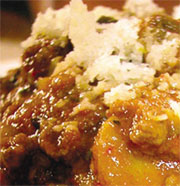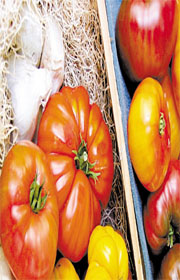The nightshade family jewel

The experience made me wonder how far Western culture has penetrated into Korea, beyond the obvious examples of designer bags and clothes.
Also, given Wynette’s immortal line “After all, he’s just a man,” I considered whether Korean men are now able to penetrate the kitchen, a domain that has been the preserve of Korean women.
A good medium through which to explore both issues is tomatoes. This is tomato season. On the streets of Seoul there is a big crop of Bongo trucks with a heavy cargo of tomatoes on board. The red fruit of the tomato plant ― yes, it’s a fruit, not a vegetable ― is the essential ingredient in Italian cuisine.
I have heard Koreans referred to as the Irish of Asia. However, I have yet to hear anybody call them the Italians of Asia, despite the fact that Italian restaurants are the most common form of international eatery in Seoul.
This may explain why so much Italian food served here is of poor quality. On most occasions, the tomato ragu has been mixed with too much sugar, an additive often overused in Korean dishes, which brings out the fruity elements of the tomato in an unappetizing fashion. And it is frequently served with kimchi, proving that foreign cuisine is sometimes treated here like the Christians who arrived in the 19th century ― it must be beaten into shape before it’s finally allowed to rest in peace.

Bolognese sauce
I started out at Veggie Hill, on the border of Haebangchon.
On any Saturday morning the two alleys that form this “hill” are bustling with ajummas squeezing every vegetable in sight. As well as the regular storeholders there are also farm trucks selling produce from their flatbeds. As this strip is also home to three fabulous tteok shops it’s best to arrive early, buy some tteok and coffee, and search for bargains.
Bolognese sauce originated in Bologna, the undisputed food capital of Italy. Located in the fertile Po River Valley, its cuisine is hearty and rich, dense with vegetables, meat and cheese. Substituting the Han River for the Po, we can make a leap of imagination and think of Seoul as the Bologna of Korea. This is good mental preparation for starting to cook.
True bolognese sauce does not use too many tomatoes. Its color should be more brown than red, which is why the vermillion offerings found in most of Seoul’s Italian restaurants are already trading at a big discount to authenticity. Hence my shopping began with mushrooms ― the button variety ― and carrots and celery. I didn’t buy tomatoes because I already had some, bought for 2,000 won per kilo directly from a greenhouse in Hang-dong, Guro District, on the verdant border between Seoul and Gyeonggi.
In true Bologna style, I had already processed the tomatoes. This is essential to the dish. A few days before the bolognese is to be made, take tomatoes and process them in a food blender.
The object is to create a thick mix, not tomato juice, so don’t let them blend too long. The fruit should be blended with herbs ― preferably oregano ― and one clove of chopped garlic per tomato. Once completed, the mixture can be stored in a sealed glass jar in the refrigerator. There it marinates and becomes wonderful.
Just opposite the entrance to Veggie Hill there is one of the best butcher shops I have encountered in Seoul. I go there for beef flank. Tell the proprietor you are making spaghetti sauce and he will grind 10,000 won ($11) worth of beef that tastes better than some of the sirloin sold in department stores at three times the price. And buy bacon ― it’s not possible to make good sauce without bacon.
Back home, step one is to make a soffritto, a semi-fried mix consisting of two cups each of mushrooms, carrots, onions and celery. The vegetables should be fried over medium heat in extra virgin olive oil for around 10 minutes. Remove the mix to a side plate and then fry two cups of finely chopped bacon for two minutes, before adding the beef. Fry this mixture for 10 minutes or until the beef resembles breadcrumbs.

Italian food cooked with Korean tomatoes, shown below. By Ko Juran
After a few sips of the cab, remove the meat from the heat. Mix in the soffritto and allow to stand for five minutes.
This would be a good moment for a few more sips of cab and a quick reflection on the fact that tomatoes, the final ingredient, are members of the nightshade family, which largely consists of poisonous berries, like Solanaceae (deadly nightshade). They are also related to tobacco, which is also known for its fatal effects.
However, the tomato itself is well established as one of the healthiest foodstuffs one can eat. The meat and vegetable mixture will now be reheated. Once it’s steaming, add six cups of the tomato puree. The secret is to be patient. The bolognese should be permitted to simmer for six hours. After that, boil water in a large saucepan and cook tagliatelli ― not spaghetti. The thicker pasta is a much better accompaniment for the sauce.
Korean men who follow these steps will achieve two things: They will prove that Italian culture can thrive here, and they will demonstrate that they are strong enough to eject their mothers-in-law from the kitchen.
By Daniel Jeffreys Deputy Editor [danielj@joongang.co.kr]










with the Korea JoongAng Daily
To write comments, please log in to one of the accounts.
Standards Board Policy (0/250자)